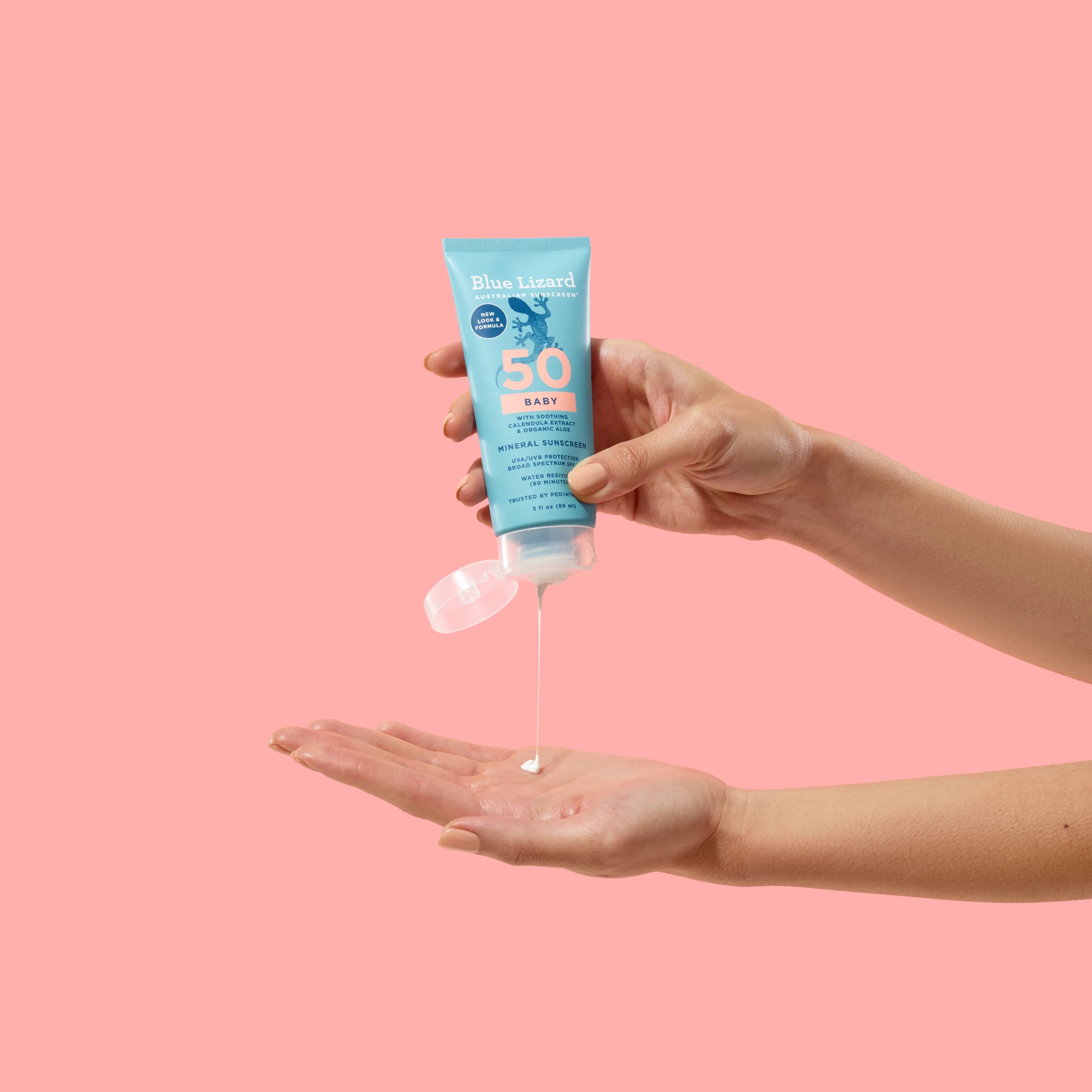Spray sunscreens are everywhere and for a good reason. They're so easy to use – just spray, rub in, and go!
But not all sprays (even mineral ones!) are created equal, and there are factors you need to consider before choosing a spray sunscreen for you and your family.
In this guide, we'll go over nine things to know before purchasing a spray sunscreen. By the end, you'll know how to make the best choices for your skin and the environment.
1. Go Mineral
When it comes to buying sunscreen, there are two major types: chemical and mineral sunscreen.
Chemical sunscreen absorbs into the deeper layers of your skin along with the sun's rays.
So, what makes mineral sunscreen different? Mineral sunscreens use Zinc Oxide or Titanium Dioxide to block dangerous UV light from ever reaching the skin.
Instead of absorbing into your skin, mineral sunscreens form a protective layer on your skin's surface and deflect UV rays like thousands of tiny shields.
In addition to this, mineral sunscreen's active ingredients don't absorb into your body. This greatly reduces the chance of irritation and makes it the perfect spray sunscreen for sensitive skin.
2. Spray Sunscreen Should Not Contain Titanium Dioxide
Zinc Oxide and Titanium Dioxide are some of the best active ingredients to help protect you from UV rays. Titanium Dioxide provides broad-spectrum protection from UVA and UVB rays and is included in many mineral sunscreen lotions.
However, Titanium Dioxide should not be included in spray sunscreen.
California recently issued a Proposition 65 warning against airborne Titanium Dioxide. According to the warning, airborne Titanium Dioxide particles are so small that there is a high risk of them being inhaled. This can lead to lung problems.
This warning is only for airborne Titanium Dioxide. Sunscreen lotions that include the mineral are perfectly safe.
While it is a great broad-spectrum active ingredient for sunscreen lotions, Blue Lizard spray sunscreen does not include it. Instead, we use zinc oxide spray sunscreen to keep you and your family safe.
3. Protect and Nourish Your Skin
Sun exposure doesn't just damage your skin with UV rays; it also dries it out. When shopping for sunscreen, look for options that include ingredients to both protect and nourish your skin.
Some moisturizing ingredients to keep an eye out for include aloe vera, shea butter, sunflower oil, and Vitamin E.
Blue Lizard spray sunscreens contain all these ingredients, as well as nourishing botanicals. Our sunscreens are also antioxidant-enriched.
This combination helps you stay moisturized and promotes softer, healthier-looking skin.
4. Broad Spectrum Protection Is a Must
You've probably heard this before, but you need to make sure that the sunscreen you're purchasing offers broad-spectrum protection. That means it's protecting you from both UVA and UVB rays.
But what does that actually mean, and why does it matter?
When you imagine harmful rays from the sun, UVB rays are probably what come to mind. These rays are the main culprit behind sunburn and skin reddening.
They can vary in intensity depending on the weather, time of day, and location. UVB rays typically cannot penetrate clouds, fog, or glass.
Now UVA rays are a bit sneakier. They are present in equal intensity during all daylight hours and can penetrate clouds, fog, and glass.
UVA rays play a smaller role in sunburn than UVB rays do, but they can still cause DNA damage to your skin.
UVA radiation is also primarily responsible for premature skin aging. This is because it penetrates more deeply into the skin than UVB rays.
Both UVB and UVA rays can damage the skin's DNA to the point that genetic mutations occur, which can lead to skin cancer. With the combined risk of sunburns, premature aging, and skin cancer, UVA and UVB rays make an insidious team.
Protecting against both with broad-spectrum sunscreen is essential for keeping your skin healthy.
5. Propellant Matters
Many spray sunscreens use traditional aerosol as a propellant. Some aerosols such as isobutane can contribute to global warming and smog problems.
One person using an aerosol product won't destroy the ozone layer. However, scientists say billions of people using them every day can cause significant damage.
These reasons are why our mineral sunscreen spray uses an earth-friendly propellant that is a breakthrough type of aerosol with ultra-low global warming potential. You can protect yourself from the sun and feel good about the impact you're having on the environment.
When shopping for spray sunscreen, check on the bottle to see if it uses an earth-friendly propellant. Try to avoid sunscreens that don’t if you can help it.
6. Reef Safe Spray Sunscreen
Let's talk about some other chemicals that may be harming our environment.
It's estimated that 4 thousand to 6 thousand tons of sunscreen chemicals enter coral reefs every year. That's more than 60 million bottles of sunscreen!
Oxybenzone and Octinoxate are two chemicals found in nearly 65% of all non-mineral sunscreens. Some studies have shown that when these chemicals come into contact with coral, they can agitate its immune system and cause it to bleach. Nearly 50% of the world's reefs have died within the last 30 years. Everyone needs to do their part to help protect these vibrant and essential biomes.
If you're planning to visit a beach with close proximity to coral reefs, you need to be extra conscious of the impact your sunscreen can have. This is why Blue Lizard's We Love the Reef sunscreens are made without Oxybenzone and Octinoxate. You can feel good about using reef-friendly sunscreen that does not contain these two chemicals believed to cause damage and ultimately the death of our coral reefs.
7. Look for Water and Sweat Resistance
Yet another thing to look for when selecting a sunscreen is its water resistance and sweat resistance.
Water and sweat resistance help sunscreen to stay on your skin. Otherwise, the excess moisture can cause the sunscreen to bead up and drip right off. This leaves your skin unprotected from damage caused by UV rays.
Based on standard testing, the amount of water resistance a product has is determined by how long a sunscreen will stay on wet skin while swimming or sweating. No sunscreen in the US is rated higher than 80 minutes of water resistance, as regulated by the FDA.
Blue Lizard offers some of the best mineral spray sunscreen options when it comes to water and sweat resistance. Our Sensitive, Kids, Active and Sport spray sunscreens provide a full 80 minutes of water and sweat resistance. This way, you can enjoy fun in the sun for the longest possible time before you have to reapply.
8. Check for Fragrances, Parabens, and Phthalates
Parabens and phthalates do not belong in sunscreen. Period.
Parabens are preservatives that block bacterial and mold growth in cosmetic products. Essentially, they extend their shelf life. Phthalates are included in all kinds of products including nail polish, hairspray, perfume, and aftershave.
Many studies have shown that parabens and phthalates have potentially harmful effects on the body, with some of the most frequent side effects as contact dermatitis and skin irritation.
The Environmental Working Group has warned against parabens and phthalates for years. That's why none of Blue Lizard's sunscreens include them.
If you have sensitive skin, another thing to watch out for is a sunscreen that includes fragrances—one of the most common skin irritants in sunscreens. Our Sensitive skin Spray Sunscreen, Kids Spray Sunscreen and Sport Spray Sunscreen do not contain fragrances and are great, safe options if fragrances irritate your skin or allergies.








